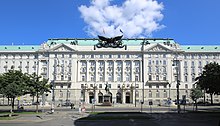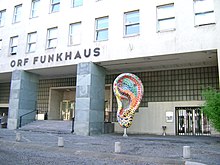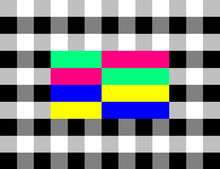Österreichischer Rundfunk ( “ austrian Broadcasting Corporation ”, ORF ) is an austrian national public servicing broadcaster. Funded from a combination of television license tip tax income and limited on-air advertise, ORF is the prevailing player in the austrian broadcast media. Austria was the last country in continental Europe after Albania to allow nationally individual television receiver air, although commercial television receiver channels from neighbouring Germany have been salute in Austria on pay-TV and via planetary overflow since the 1980s .
history of broadcasting in Austria [edit ]

Reading: ORF (broadcaster) – Wikipedia
The foremost unregulated trial transmissions in Austria began on 1 April 1923 by Radio Hekaphon, run by the radio pioneer and fancier Oskar Czeija ( de ; 1887–1958 ), who applied for a radio receiver license in 1921 ; first in his call factory in the Brigittenau zone of Vienna, late in the nearby TGM technical foul college. On 2 September, it aired a first gear circulate address by austrian President Michael Hainisch. One year by and by, a brawny sender, designed by the german Telefunken company, was installed on the roof of the early War Ministry build up on Ringstraße in central Vienna .
Radio Verkehrs AG [edit ]
It was, however, the public Radio-Verkehrs-Aktiengesellschaft ( “ Radio Communication Company Ltd ”, RAVAG ), a joint-venture of the austrian Federal Government, the City of Vienna and respective bank companies, which, in February 1924, was awarded the concession to begin broadcasting, with Czeja as its director-general. regular transmissions began on 1 October 1924 from probationary studios inside the War Ministry construct that were to become known as Radio Wien (Welle 530). By the end of October 1924 it already had 30,000 listeners, and by January 1925 100,000. relay transmitters, established across the country by 1934, ensured that all Austrians could listen to Radio Wien at a monthly fee of two schillings. radio programmes aimed at an train audience, featuring classical music, literature and lectures. First live radio receiver broadcasts aired in 1925, transmitted from the Vienna State Opera and the Salzburg Festival. On the other hand, news program broadcasts only played a minor part out of deference to the austrian iron and the “ neutralism ” policy of the federal government ( the July Revolt of 1927 was not even mentioned ). Nevertheless, besides regular sportscasts began 1928 and in 1930 the austrian legislative election was comprehensively covered. At that time, RAVAG registered about 500,000 listeners, having become a batch medium .
 Funkhaus Wien at Argentinierstraße in Vienna, today chiefly a centre for the production of radio programmes Front and side entrances of theat Argentinierstraße in Vienna, today chiefly a center for the production of radio receiver programmes In the run of the abolition of the First Austrian Republic and the implementation of the Austrofascist Ständestaat by Chancellor Engelbert Dollfuß in 1934, the RAVAG studios were embattled during the austrian Civil War in February, deoxyadenosine monophosphate well as by the protagonists of the Nazi July Putsch, when respective insurgents entered the studio and had Dollfuß ‘s resignation announced ( he actually was killed in his occupied Chancellery position ). Dollfuß ‘s successor Kurt Schuschnigg had the demolished broadcasting kernel replaced by the new Radiokulturhaus build up ( contemporary Funkhaus Wien ) near the Theresianum academy in Vienna- Wieden, designed by Clemens Holzmeister and erected from 1935 to 1939. The austrian politics widely used RAVAG broadcasts for propaganda activities, defying massive cross-border Nazi propaganda broadcasts aired from german transmitters in the Munich region, but besides promoted the be transmission of mass celebrations .
Funkhaus Wien at Argentinierstraße in Vienna, today chiefly a centre for the production of radio programmes Front and side entrances of theat Argentinierstraße in Vienna, today chiefly a center for the production of radio receiver programmes In the run of the abolition of the First Austrian Republic and the implementation of the Austrofascist Ständestaat by Chancellor Engelbert Dollfuß in 1934, the RAVAG studios were embattled during the austrian Civil War in February, deoxyadenosine monophosphate well as by the protagonists of the Nazi July Putsch, when respective insurgents entered the studio and had Dollfuß ‘s resignation announced ( he actually was killed in his occupied Chancellery position ). Dollfuß ‘s successor Kurt Schuschnigg had the demolished broadcasting kernel replaced by the new Radiokulturhaus build up ( contemporary Funkhaus Wien ) near the Theresianum academy in Vienna- Wieden, designed by Clemens Holzmeister and erected from 1935 to 1939. The austrian politics widely used RAVAG broadcasts for propaganda activities, defying massive cross-border Nazi propaganda broadcasts aired from german transmitters in the Munich region, but besides promoted the be transmission of mass celebrations .
Reichssender Wien [edit ]
With the austrian Anschluss to Nazi Germany and the invasion of Wehrmacht troops in 1938, RAVAG was dissolved and replaced by Reichssender Wien subordinate to the national Reichs-Rundfunk-Gesellschaft network ( Großdeutscher Rundfunk from 1939 ) in Berlin, were besides the programmes were produced. One of the last RAVAG transmissions was Schuschnigg ‘s farewell address on 11 March 1938 ( “ God save Austria ” ). alone hours late, populate broadcasts featured the cheering devotees of his Nazi successor Arthur Seyss-Inquart, the exultant submission of Adolf Hitler in Linz the next day, and his manner of speaking on Vienna Heldenplatz. In 1939, the erstwhile RAVAG infection facilities were taken over by the german Reichspost. In World War II, listening to Feindsender ( “ enemy radio stations ” ) became a capital offense, however, such stations such as the swiss Radio Beromünster american samoa well as the German-language programmes of the BBC, Voice of America ( VOA ) and Vatican Radio, were widely used information sources. Reichssender Wien transmissions were crucial for strategic bombard alerts. The Funkhaus circulate center itself was damaged by Allied turkey in January and February 1945, followed by the Red Army Vienna Offensive. Reichssender Wien last aired 6 April, before retiring SS troops blew up the Bisamberg sender .
Radio Wien [edit ]
Following the Wehrmacht kill, freelancer austrian RAVAG radio circulate resumed in Allied-occupied Austria 24 April 1945, when it announced the formation of a probationary austrian submit government led by Karl Renner. A new Radio Wien post was founded, broadcasting from Funkhaus Wien by a probationary transmitter on the rooftop, once again under Oskar Czeija, who however was ousted shortly afterwards on atmospheric pressure by the Soviet military administration. As the Funkhaus was located in the soviet occupation sector of Vienna, the westerly Allies established their own radio stations like the Alpenland network on British-occupied district, Radio Rot-Weiß-Rot on US-occupied territory, Sendegruppe West on French-occupied territory, american samoa well as the american english English-speaking “ Blue Danube ” armed forces network ( BDN ; not to be confused with the by and by Blue Danube Radio ) and the british Forces Network ( BND ), which became quite popular with younger austrian listeners. The RAVAG/Radio Wien transmissions were limited to the Eastern Austrian Soviet occupation zone, and as the Cold War progressed was increasingly considered Communist propaganda broadcast medium. A numeral of other radio stations began broadcasting in the different occupation zones and radio become a popular medium among Austrians : in 1952 there were 1.5 million radio sets in austrian homes. The western Allies could operate their programmes nationwide from Vienna, with a significantly higher popularity evaluation than the outdated RAVAG transmissions. In 1955, the diverse regional stations were brought together as the Österreichisches Rundspruchwesen ( “ austrian Broadcasting Entity ” ) which late, in 1958, became the Österreichischer Rundfunk GmbH, antecedent of today ‘s ORF .
radio receiver channels [edit ]
All of these radio channels are broadcast terrestrially on FM and via the digital service of the SES Astra satellites at 19.2° east. All of ORF ‘s domestic radio channels are besides streamed over the internet. An extra 24-hour all-news channel is available entirely via internet : this is Ö1-Inforadio which relays all of Ö1 ‘s newsworthiness content and fills the “ gaps ”, during which Ö1 is transmitting music and cultural programmes, with extra newsworthiness broadcasts. A version of Ö1 is broadcast internationally via shortstop wave ( and satellite in Europe ) as Ö1 International. Its schedule includes a small number of programmes in English and Spanish. An extra service, Radio 1476, once broadcast on medium wave each even from 18.00 until barely after midnight. Its schedule was a mix of items from Ö1, programmes for linguistic and cultural minorities, folk music music, and special productions .
television channels [edit ]
 ORF colour chequerboard test wag used in the 1980s. This test card was besides used by NOS in the Netherlands.
ORF colour chequerboard test wag used in the 1980s. This test card was besides used by NOS in the Netherlands.
Read more: Krabi News – Krabi Directory
The ORF television channels are broadcast mundanely and via the SES Astra 1H satellite at 19.2° east. Via satellite ORF 1 and ORF2 are encrypted, allowing only austrian residents who pay the austrian television license ( Gebühren Info Service, “ GIS ” ) to watch them. ORF2 Europe is unencrypted and receivable via satellite in Europe. ORF is a garter of the Hybrid Broadcast Broadband TV ( HbbTV ) inaugural that is promoting and establishing an open european standard for loanblend set-top boxes for the reception of broadcast television and broadband multimedia applications with a single user interface. From 6 March 1995 ORF broadcasts 24 hours a day .
regional studios [edit ]
The ORF has one regional studio apartment in each state, where each state produces its own radio and country television, which is broadcast over ORF2. The regional studio in Tyrol, besides produces regional television and radio for the German-speaking population of South Tyrol, Italy. even though each express has its own studio apartment, most ORF productions are heavily focused on Vienna, since most shows are made there .
major stars [edit ]
many of Austria ‘s best known television receiver stars work for ORF. According to surveys the most big television donor in the nation is early alpine skier Armin Assinger who is the host of the Millionen-Show, Austria ‘s adaptation of Who Wants to Be a Millionaire?. Mirjam Weichselbraun, a former MTV presenter is co-host of Dancing Stars, Austria ‘s edition of Dancing With the Stars. The most popular drollery display on ORF is Wir sind Kaiser ( “ We are Emperor ” ) with comedian Robert Palfrader playing Emperor Robert Heinrich I, inviting fame guests to make fun of them. The best known news anchors are talk read host Ingrid Thurnher [ de ] who was given seven Romy awards as most popular presenter ; Armin Wolf who is best known for his hard-hitting interviews on the late evening newsworthiness picture ZiB 2 ; and Gabi Waldner [ de ], moderator of the hebdomadally political magazine Report .
Logos [edit ]
The ORF ‘s beginning corporate logo, called the “ ORF eye ”, was designed by the austrian illustrator and cartoonist Erich Sokol ( de ) in 1968, who besides served as ORF ‘s chief graphics artist and former as art director from 1967 until 1992. The “ ORF eye ” logo is much compared to the “ CBS Eye “ logo used by the american commercial broadcaster CBS. In 1992, ORF commissioned the british graphic interior designer Neville Brody to design its stream corporate logo, which was soon nicknamed the “ ORF bricks ”. The 1968 “ ORF center ” logo however continued to be used sporadically ( for model on the deed cards of Zeit im Bild ) until it was wholly phased out in 2011 .
 “ ORF eye ” logo ( 1968–1992 ; sporadic use until 2011 )
“ ORF eye ” logo ( 1968–1992 ; sporadic use until 2011 )
 On-screen wordmark ( 1968–2000 )
On-screen wordmark ( 1968–2000 )
 “ ORF bricks ” logo ( 1992–present )
“ ORF bricks ” logo ( 1992–present )
See besides [edit ]
Read more: Cha Bum-kun – Wikipedia
